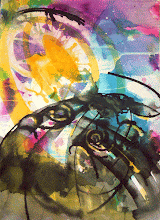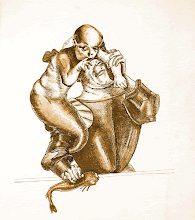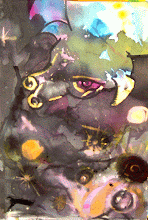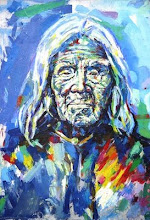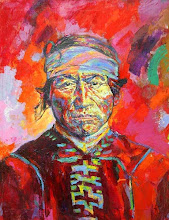Art
To properly talk about Contemporaneous Mapuche Art, we neccessarily have to discuss the meaning of the term art. This conceptual quest for definition has already been made throughout western philosophy, and from that point of view we can not definitely state what Mapuche art is. Yet, regardless the theoretical camp we place ourselves to identify this term, art is present in everything where human expression manifests itself in this world. We could say that art is whatever we see as such, regardless the person who reads it. Thus, an erudite reader would see art where common people would not be able to see it. Same thing, the people would see artistic expression where the scholar would only see garbage.
We will refer to art as the construction, both aesthethical and formal, of highest spiritual expression.
Perhaps, in the Mapuche world we will not treat art in the same way the Western world does, but from the Western point of view we can certainly distinguish some elements that might allow us to talk about works of Mapuche contemporaneous art.
One of the most difficult-to-conceive notions pertaining to the concept of Contemporaneous Mapuche Art is that of integrated art, such as politically integrated art, for instance, without being official art. In Western culture, integral art is a constant quest. In Mapuche culture, integral art constitutes the very basis.
One element that will help us understand Mapuche art is its dissociation from Chilean art, reaffirming the idea that Mapuche people constitute a nation apart and distinct from Chilean society. Hence, art is the expression that unveils and higlights our existence in the world. It is the desire of every Mapuche to express a feeling that dwells within their own piwke (heart).
Art and Economic Power
Economic power, the motor of predation that sets the Western world in motion, is the one that determines the apreciation of how art is observed. That is, what the individual should see as art is what the power demands. Regardless the ideological stream where the work of art has its roots and from where fights domination, economic power exerts a sort of hypnotic effect on the rest of ideas, only promoting them in the sense of supporting the dominant idea, without provoking an on-dévenir advance that would lead to the development of human culture.
Certainly, in Latin America there is a condition of subdued culture, in most of those peoples whose worldviews are determined by the dominant ideologies.
The democratic practise of art expresses itself in agreement with the pattern dictated by economic power. It is one pattern which determines and articulates all the conditions that converge for the experience of art to become concrete. This power, for mentioning one aspect, is exerted from the globally highest-ranked apparatus of visual control, from the main source that generates most visual product in these days: television. Television as an expandable concept is the medium where all development in ideological, religious, economic, moral, philosophical and further spheres of the human world get mixed, and the final “visual product” reaches the individual with its constituents already processed. Then the consumer does not engage in interaction with spiritual expressions, but with formal objects, which have been engineered by those in power in order to control and put pressure on both the individual and collective mind.
Television frames do not put on scene cultural differences. This visual body exposes before us the illusion of unified culture, the chimera of shared, egalitarian nacionality. This observation is emphasized to mean that our personal, group and social worlds are overlapped, being this the reason why there is one government serving as a means to rule. Therefore, every wound in our collective soul finds its sore in each of us through the others, a sore that eventually tears down our collective desire.
The denial and stereotype of the Mapuche’s cultural condition is imposed by the predatory power. This is how the Chilean mestizo loses touch with their ancestral roots, in order to become assimilated into the fragile thread that listlessly binds them with the heart of the absent father.
When the genesis of the work of art is not based upon a part of the predatory engine, it is excluded from the cultural and commercial circles. Those in power are aware of this effect, and knows that the Leviathan is bound to steer the world’s order. When the work is perpetrated from the cultural spheres that fall outside those tolerated by the economic power, hindering in this manner the plan for depredation, it becomes a “terrorist threat.”
Intercultural mixing in Chile and Latin America
«They have not been able either to eliminate us or erase the memories of those of us who were indigenous, for we are the culture of the sky and the earth, we are the ancient descendants and we are millions, and although the whole universe collapsed, our people will continue to live, even beyond the empire of death.»
(Solemn Declaration, Junta General de Caciques, 1991)
There is suppression against the visual circulation of the indigenous people-nation in several Latin American countries. This is a very common practise in the domineering State. The negation of existence, submitting the people to this deception like a controlled hypnosis, and those worst affected are the indigenous people that inhabitate most of Latin America’s territory.
Generally, Chile’s cultural scene does not open any windows to the true practise of being Mapuche within the environment in which they take part. In the definition of art, if seriously posed, there is complete ignorance about the ancestral aesthetics.
For instance, in Chile and particularly in Osorno city, at least eighty percent of the population have indigenous descent, but the authorities, the intelligentsia, politicians, the clergy and even the Chilean people deny the existence of others and of themselves. Ironically, Osorno shows itself to the world as a pluricultural city made up of many diverse colonies. However, to the eyes of those foreigners who have visited this land, its streets show the ancient, anguished look of a people submitted to a cultural imposition that keeps them shut away within their own bodies.
In Rawe’s sector there is a sacred place, Txen Txen and Kaikaifilu, where the people used to hold ancestral ceremonies (and they still do). Around the ancient culture there are also irreducible cultural expressions regarding the Mapuche philosophy, and eventually, their worldview. All this implies that, through these manifestations, it involves what today is called music, performing and visual arts, architecture and so forth.
We can assure that the history of art in Rawe is about 2000-9000 years long, since this sector’s cultural elements are analogous to those found at the Monte Verde human settlement, an archaeological site located by the road between Puerto Montt and Osorno, the findings of which submit the Clovis First theory to a situation of historical absurd. One could downright and proudly state that Rawe’s history dates back to 9000 years at least. The art of all those who see the world from this ancestral point of view follows and passes on the tradition, perpetuating a worldview of which we feel we are part. Mapuche art is both contemporaneous and ancestral at the same time, since it does not invent either the signs or the philosophy contained in it. It freely opens out in all its extension, according to how life develops on its own.
Chilean television has shown a perverse picture of the misnamed “conflicto mapuche” (Mapuche conflict), after both the regrettable homicide against our peñi Matías Catrileo, member of the Coordinadora Arauco Malleco, and the hunger strike carried out by our lamuen Patricia Troncoso, besides the unfair arrest of our peñi Héctor Llaitul under the application of the “anti-terrorism” law, a legacy from the militar dictatorship. By putting this law into practise, the Chilean state does not acknowledge the Mapuche people’s condition, that is, it does not acknowledge a structure, a society ruled under cultural elements of their own.
One of the offshoot ideas is that “the problem of the Mapuche is not the existence of the Chilean and their stay inside the territory, but the transnational capital, the predation over human dignity. Chilean society is troubled with its own soul and charges the Mapuche people with this problem.”
Besides, we could state that Mapuche art is not the remains of Chilean art. Chilean art continues to be colonialist, scarce of identity at its best. On the contrary, Mapuche art is that of the human being inhabiting this world, with their own identity, territory and worldview.
Finally, the oversight of a people’s cultural expression equals the murder of the human being who lives beneath.
Illustration and the mestizo world
«There are only two worlds; the world of the human beings who dwell on earth: the Mapuche –people of the earth- and that of the other beings who do not belong here, but prowl around and outside this land.»
(Ñaña Francisca Aucapán. Ralko Lepuy, Pewenche People)
Illustration is the exposure of one idea in a tutelary manner, as well as the possibility of attaining information expressed in practical, simple terms.
Thus, when the work of art is the faithful copy of the idea, it illustrates the reader. This has been a constant feature in the history of Western art.
It is the Western cultural egocentrism that craves for establishing its own supremacy in order to redeem other human groups to its use and likeness.
The West’s decadence into the postmodern society comes to confirm an ideological chaos that makes evident the poorness of this cultural system that places itself against the Mapuche world.
Chilean mestizos, who constitute the widest share of Chilean population, do not recognise their historical double composition: the local and the foreign. It is the vain feeling arisen from this latent ambivalence that gives place to the installation of predatory power.
The Mapuche visual world as known by the Chilean mestizo, is based on the representation of visual elements that belong to the Chilean western culture. All of this through chronicles that sang the praises of the ancient inhabitants of this territory (certainly a common practise among power spheres in which they tried to lower the people’s guard against plundering power by glorificating them), which showed primary situations regarding the happenings of the first years since the genesis of Chilean nacionality, folklorised situations, recognition of being in the world itself. In the same path, European 19th-century photographers portrait ambiguous situations featuring Mapuche families in dramatised scenes. This colonialist imagery is called the basis of the nation, the criollo, the autochthonous. Folklor comes to take its place as an illustration of the Chilean, the colony-people, an illustration to understand themselves and to understand the original world, where new life was handed to their ancestors; in short, to have an image of themselves in this new world. Recently, this was done by Violeta Parra, Victor Jara and further artists of Mapuche descent. Folklore is the false image of the original reflection. Folklore uses autochthonal elements dissociated from its source. Shapes, colors, sounds are the interpretation of an original idea, which might express the feeling of a colonised people who cling to living cultural elements that are part of this territory, and in this manner settles a fleeting difference that makes them conceive an idea on their own and about themselves.
Our hybrid peoples are wandering in this schizophreny, with their desire concealed. It is a social schizophreny in the sense of an unauthentic, non-self-belonging expression, like a split living, uncapable to find one’s own body, isolated betwixt two worlds. Frequently, the image that the indigenous conceive about themselves comes not from their own reflection but from the image that power wants them to have about themselves and their siblings. The spiritual fragmentation usually turns us into suspicious enemies. Not accepting this forced reflex means the exclusion from the social system.
When the image is separated from what is meant to be represented, shows up what in certain moment of Western history was called the world of shadows, the equal to the origin. For instance, Plato considered painting as an inferior art because it was a copy, contrary to the truth, and eventually contrary to beauty. Nowadays, contemporaneous art proves that the beautiful is not necessarily the true, among other things.
Perhaps the Mapuche world does not conceive art in the same way the Western world does, but in the West we can indeed distinguish some elements that might let us talk about Mapuche works of art. This is not new: already in the 14th century, Alberto Durero, a Renaissance man par excellence who lived in north Europe, when examining some headdresses, silver work and jewelry, said: “This art you bring before me is the highest self-respecting art, as superior as the best European art, and these people might be called artists and creative geniuses.”
In our hearts we are what we want to be, but every fellow has an idea that would clash with the value of our own ideas. However, the Western artistic expression poses: what does my piwke (heart) wish? The answer to this might be “what the power and the dominant ideology demand.”
Whenever a culture like the Mapuche expresses its heart-dwelling desire, it not only represents the act of representing the idea or the desire, but also the act of creation and its product are the reason of that desire, since their very beginning through their final concretion. The artistic gesture is itself the expression of the unified movement where the reading of the cosmos, the human world and the object become one. The artistic creation, the work, are the physics of the trascendental.
Colors, rythms, shapes, sounds, movements, textures, etcetera, are necessary means to express what lies inside one’s soul.
The Mapuche people know that their self-image may vary and depends on both the sociopolitical context and position of each individual. Everything connected with their worldview comes to determine the aesthetic view to confront the dominant ideology. The view about the use of formal elements adapts through an appropriation of the visual spaces originally belonging to the Western world.
As far back as the horse’s introduction, the silver coins minted by the Chilean state (material for making trapelakuchas), idiom, religion, and politics are all of them cultural elements which have allowed the persistence of the ancestral culture. This split heart-dwelling desire looks for its route previously traced, and finds it in itself and in their equals. The natural geography determines the sense of this desire, and the position involves worlds located in certain physical spaces, and from there, the whole world, the universe.
Paradoxically, we cannot talk about Chilean art, and at the same time consider works of Mapuche art dating back to thousands of years, since Chile was just formed as a nation-state in 1825. The Spanish Crown should also consider Mapuche expressions as a part of their art history, because during the conquest and colonial periods the Wallmapu was their territory, according to their accounts. The only way Mapuche art may be considered Chilean art, is through the conquest of the Mapuche territory. This is an evident example of the idea of deleting the heart-dwelling desire by means of military power and forceful domination.
The original, the autochthonous, does not require to illustrate what is its own. The work, through action, articulates the heart-dwelling desire.
Mapuche contemporaneous art is embedded from the viewpoint of appropriated elements, and adapted media, techniques and concepts.
Gesture, action and work
The gesture is the drive that arises from the heart-dwelling desire. The option that engages elements in order to break through the established structure. The precise movement that provokes the alteration of the subjugating order. The conceptual contortion that restores one’s own order.
The action is the execution of the opus with moves, spaces and verbs appertaining to the Mapuche worldview. The organisation of both elements and raw materials in their own pace and spacial situation.
The work is the object resulting from the process that begins with the heart-dwelling desire. The shapes it takes are determined by the action, whereas the gesture means its positioning within some context, so that the work may impulse the valve that frees both the individual and collective desire.
In the process of cultural assimilation into the Western Chilean society, a strategic subordination is assumed and in this way, the concept of art is fixated and appropriated. The concept is taken by the actors in order to survive and carry on the piwke’s desire beyond oneself.
All good art comes forth from the heart-dwelling desire, it is the private feelings we wish to express. Regardless we reach our goal or not, it is always there, waiting for the proper moment to come out and become flesh. Dreams, whatever they are, become part of our worldview. Tradition, ceremonies and all elements of Mapuche worldview arise from the heart-dwelling desire. They are wishes that keep throbbing through all times, no matter how distant they are.
The Mapuche nation, as an ancestral culture, unfurls in every old person, in the children, in the relationship with equals, in the siblings who are reflections, or the image closest to the image that represents me according to my feeling. This construction produces a network of individual wishes that becomes collective. Every man and woman hold this desire, without seeing this image in the exterior but as something that exists and we get to know only partially. There is an underground coexistence with my equal, in which’s darkness quiet networks are woven, affective networks of knowledge reunification.
Every man and woman holds a piece of their collective history, a piece that they does not touch when alone, because it only sounds in the collectivisation of that portion. Through socialisation, it makes sense in the individual as in the collective, too. In the communication, the conversation, the earth-based life, in the contact with nature, we can find the traces of the memories scattered in the innermost of the being. This individual desire is also collective.
The Mapuche culture has an ideological corpus structured through thousands of years. Art, philosophy and technology are elements that converge on the Mapuche world without being summoned. While every Mapuche turns their life into a process, a way of learning how to live as a Mapuche, the whole society does, too. The Mapuche territorial recovery becomes physical and conceptual, in a process which is proper for an integrated nation –this is their nature. Technology is an everyday reality, thus becoming a powerful “drug” that keeps our ancient peoples in this sort of lethargy; with their gadgets they elaborate the fantasy of a superior society. Art is a means of subsistence and continuity.
The contemporaneous Mapuche art adopts many shapes, with styles that are not directly defined by the preestablished mainstream. This is why the form it adopts is that of reappropriation of those styles and languages employed in the context of Western art. In this manner, a carved-wood work, according to the gesture of placing this work in context, acquires its own features within another context.
As the Mapuches’ lands have been plundered and that expoliation was carried out in all spheres of the ancestral culture, in the same way the contemporaneous practise of Mapuche art is an appropriation of the elements of universal culture, and out of this position, they state a possibility for subsistence.
Subsistence is linked to the innermost spiritual expressions, and the contemporaneous Mapuche art is one out of a set of elements bound for the reconstruction of that world.
We can say that the Mapuche art is the very art of the people and their culture’s processes. There is no art without recognition or freedom, and these cannot exist without each other, because this univocal relationship builds its structure on unification.
Author: Ragko
(translated by César André Pérez)
martes, 28 de diciembre de 2010
Suscribirse a:
Entradas (Atom)





